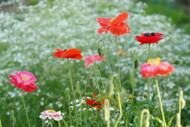How cutting back flowering wildflowers is better in the long run
One of the main factors which can affect the success of establishing a new Wildflower area is competition. This could be in the form of grasses (which are required and desired in order to create a ‘meadow’ area) or existing weeds (there is normally a pre-existing seed burden in the soil of most newly-sown areas).
In order to deal with the competition and give wildflowers the best chance of germination, establishment and ultimately longevity, it is good practise to cut back the entire sward of a new sowing throughout the entirety of the first growing season. By cutting back everything, the grasses can be kept in check, any unwanted weeds will be stopped from producing further seed, and the wildflowers are able to concentrate on developing strong roots, rather than expending their energy on attempting to flower in Year one, when they may still be immature and face competition from the vigour of grasses.
After each cut, the cuttings should be collected up and removed from site, in order to stop them from rotting down and enriching the soil, which would feed the grasses and further inhibit the chance of wildflowers becoming strong enough to establish themselves.
Inevitably, some flowers may experience good early establishment and try to flower in Year one – these will be casualties of the cutting regime during the first year but this is for the greater good and success of the meadow. The majority of species in a wildflower mix are perennial, so will re-grow and feature strongly in future years.
By carrying out the above, with a final ‘cut and collect’ carried out in late-Summer / early-Autumn, the sward can be allowed to grow unchecked throughout Year two and each year thereafter, with just an end of season cut and collect necessary after self-seeding has occurred, following the flowering displays. The only optional addition to this regime would be to perhaps add an early cut and collect in early-Spring if there has been a mild Winter, in order to bring things back in line, as a ‘tidying’ cut for the start of the growing season.

